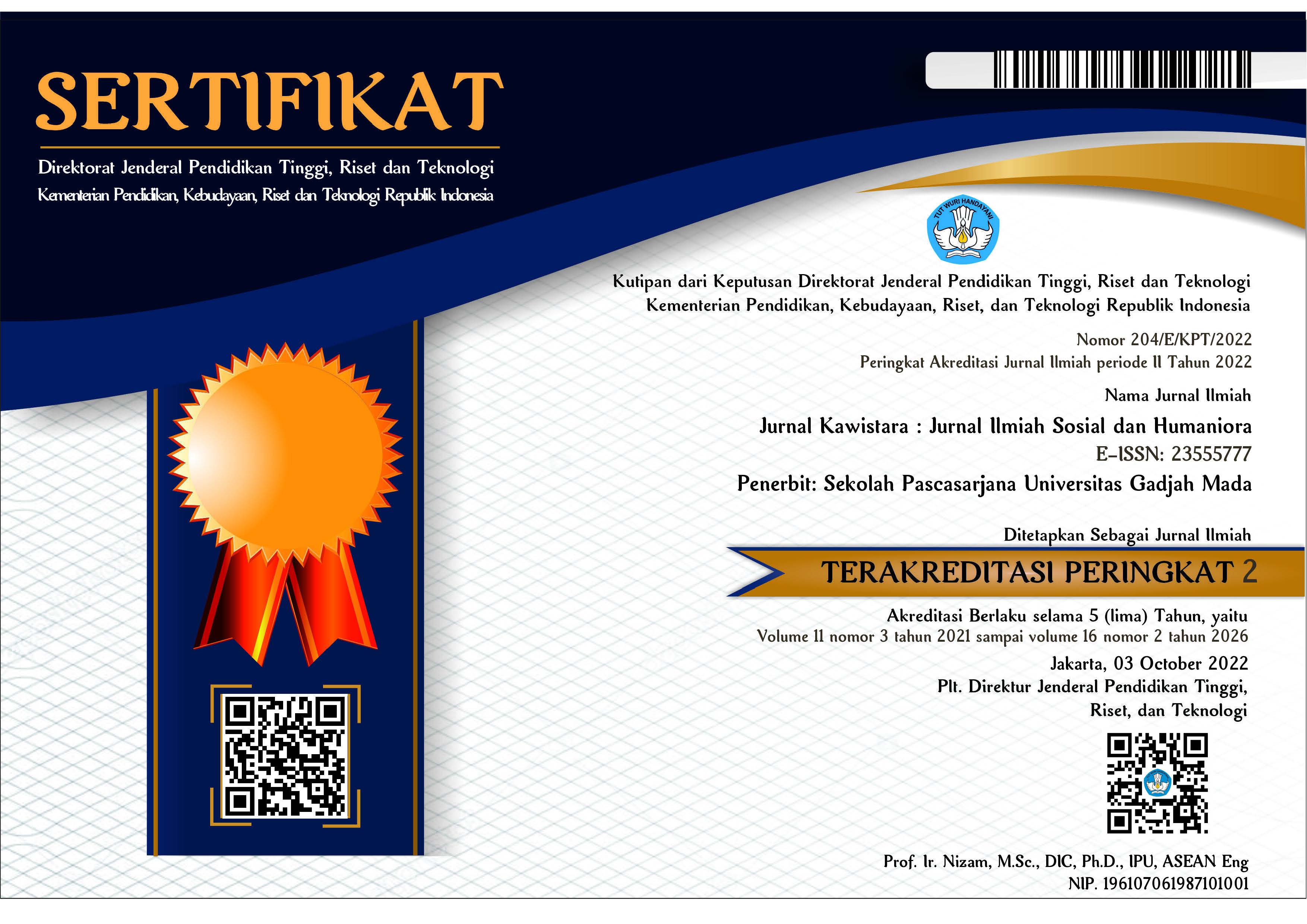The Function and Meaning of Tope’ le’leng in the Death Ritual of The Kajang Tribe, South Sulawesi
Ninik Juniati(1*)
(1) Universitas Surabaya
(*) Corresponding Author
Abstract
Tope’ le’leng in the Kajang language means black sarong and is a typical sarong of the Kajang tribe worn by men and women, both for daily wear and worn at various ceremonies held by this tribe. The study of tope’ le’leng has been quite a lot. Still, no one has discussed its function and meaning in the death ritual of the Kajang tribe, considering that tope’ le’leng has been recognized as one of the Kajang tribe’s identities among other tribes in Indonesia. This study examines the function and meaning of Tope’ le’leng in death rituals, starting from when the corpse was still at home, funeral preparation, funeral processions, and follow-up rituals until 100 days. This research used an ethnographic approach with descriptive analysis. Data analysis used triple pattern (Pola Tiga) theories in Paradoxical Aesthetics from Jakob Sumardjo. The data sources in this study are Tope’ le’leng, the funeral ritual itself, the shaman who led the death rituals, and the local community who followed the funeral ritual. Data collection techniques used participatory observation and interviews. The results showed that Tope’ le’leng functioned as an object of donation, a sign of grief. It is a marker of a family of mourning (not wearing clothes other than tope’ le’leng) as a ritual object to cover the bamboo coffin and Pammorangan. Tope’ le’leng, as a ritual object, shows the social strata or economic level of the grieving family in the community. The Kajang people believed that the deceased spirit could see the family and the shaman as long as they did not wear clothes other than tope’ le’leng for 100 days. As one of the ritual and sacred objects, tope’ le’leng has presented a moment of transcendence and belief in the existence of spirits in death rituals. Based on the triple pattern theory (Pola Tiga), namely the relationship between the upper, middle, and lower worlds. Tope’ le’leng has another function as a relationship connector between God, man, and nature. The simplicity of its form and composition does not detract from its function and meaning and even reinforces its sacredness as a ritual object in patuntung beliefs.
Keywords
Full Text:
PDFReferences
Abbas, A., Hasarudin, H., & Musi, S. (2021). Makna Tope’le’leng di Desa Tanah Toa Kecamatan Kajang Kabupaten Bulukumba (Analisis Semiotika Charles Sanders Pierce). Washiyah: Jurnal Kajian Dakwah Dan Komunikasi, 2(3), 10–22. https://doi.org/https://journal3.uin-alauddin.ac.id/index.php/washiyah/article/view/18393
Ahuluheluw, M. (2018). Ammatoa - Budaya (Kearifan lokal) suku Kajang Dalam di bulukumba Sulawesi Selatan. In L. Yuwanto, A. M. Larasati, & S. L. Prajogo (Eds.), Seminar Nasional Peranan Ilmu Psikologi Dalam pengurangan Risiko Bencana. (pp. 54–67). LPPM Universitas Surabaya.
Darmapoetra, J. (2014). Kajang:Pecinta Kebersamaan dan Pelestari Alam (1st ed.). Arus Timur.
Dewi, S., Tikson, S., Sahas, N. S., Ramadanti, W. N., & Saleh, A. J. (2020). Market Potential Tope Le’leng: Strategi Mengembangkan Industri Kecil Penenun Masyarakat Suku Kajang. Jurnal Bisnis, Manajemen Dan Informatika, 17(2), 130–140. https://doi.org/http://dx.doi.org/10.26487/jbmi.v17i2.11439
Hasan, H., & Nur, H. (2019). Patuntung Sebagai Kepercayaan Masyarakat Kajang Dalam (Ilalang Embayya) Di Kabupaten Bulukumba. Phinisi Integration Review, 2(2), 185–200. https://doi.org/10.26858/pir.v2i2.9981
Irawan, A. P. (2014). Eksistensi Kearifan lokal (Studi nilai-nilai sosial Sarung Adat Komunitas Kajang, Kabupaten Bulukumba) [Undergraduate, Universitas Muhammdiyah Makassar]. https://digilibadmin.unismuh.ac.id/upload/10944-Full_Text.pdf
Junaedi, D. (2021). Estetika : Jalinan Subjek, Objek dan Nilai (D. & S. Riwayanto, Ed.; 3rd ed.). ArtCiv.
Kurniati. (2017). Teknik Pembuatan Kain Kajang. In A. Arfandi, Sabran, Zuhaji, U. Rahmah, D. D. Andayani, Mantasia, & Harifudin (Eds.), SEMINAR NASIONAL Pendidikan Vokasi Fakultas Teknik Universitas Negeri Makassar. (pp. 301–307). Universitas Negeri Makssar.
Maknun, T., Tahir, M. D., & Suryaningsih, I. (2020). Cultural Dimension of Black Representation of Ammatoa Community: Study of Cultural Semiotics. ELS Journal on Interdisciplinary Studies in Humanities, 3(4), 651–660. https://doi.org/10.34050/elsjish.v3i4.12346
Nur, Sri W. (2017). Persepsi Masyarakat Malleleng terhadap Sarung Tenun Hitam di Desa Malleleng Kecamatan Kajang Kabupaten Bulukumba, [Undergraduate, Universitas Negeri Alauddin ]. http://repositori.uin-alauddin.ac.id/id/eprint/7829
peta bulukumba. (2020). Bulukumbakab.Go.Id. https://bulukumbakab.go.id/peta-bulukumba.
Sumardjo, J. (2014). Estetika Paradoks (1st ed.). Kelir.
Sumardjo, J. (2016). Filsafat Seni (1st ed.). ITB Press.
Article Metrics
Refbacks
- There are currently no refbacks.
Copyright (c) 2022 Ninik Juniati

This work is licensed under a Creative Commons Attribution-ShareAlike 4.0 International License.
Jurnal Kawistara is published by the Graduate School, Universitas Gadjah Mada.







